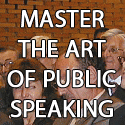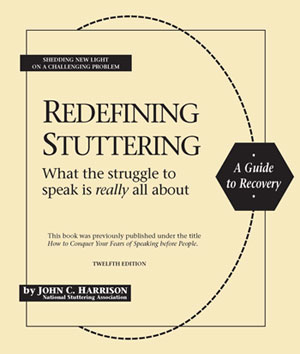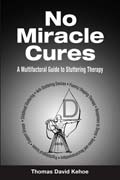As you are aware, there are many different forms of speech dysfluency that we seek speech therapy for stuttering/stuttering therapy, and in my last post I attempted to come up with a simple, “rough and ready” way to differentiate between them that I called the Stuttering Jack Scale. The reason that we need to differentiate between them, is that it is very important to know the degrees of the stuttering problem if we are to give constructive advice about potential stuttering treatment strategies for stuttering problems.
 What we must understand is that, as an adult, your personal communication style has become hard wired into your system, and unless you consciously try to alter it, that communication style is going to stay with you. This is not just the stuttering pattern but also includes such aspects as the speed of delivery, the enthusiasm of delivery, the response time, the number of words uttered on a single breath, the pause lengths within speech etc. In addition, most of the psychological responses to visual triggers have also become almost a reflex action by the time you are an adult. So in response to a certain visual or auditory stimulus, you will generally react in the same way, as far as your psychological response, and your resultant speech pattern in that situation. So you must understand that, it is going to be extremely difficult to change, over the long term, those innate responses by undertaking a short speech retraining course.
What we must understand is that, as an adult, your personal communication style has become hard wired into your system, and unless you consciously try to alter it, that communication style is going to stay with you. This is not just the stuttering pattern but also includes such aspects as the speed of delivery, the enthusiasm of delivery, the response time, the number of words uttered on a single breath, the pause lengths within speech etc. In addition, most of the psychological responses to visual triggers have also become almost a reflex action by the time you are an adult. So in response to a certain visual or auditory stimulus, you will generally react in the same way, as far as your psychological response, and your resultant speech pattern in that situation. So you must understand that, it is going to be extremely difficult to change, over the long term, those innate responses by undertaking a short speech retraining course.
There are many methods of fluency reshaping that can change your thinking and speaking behaviour in a clinical situation. Some will reduce your level of speech dysfluency a little, and some will completely eliminate it in that environment. A few are even capable of having you speak totally fluently in all, “outside the clinic”, situations for a period of time, but your innate communicating style eventually overrides the new style that you have been taught, and the stuttering will return to varying degrees, if not totally unless you can maintain your awareness and consciousness on your new speaking technique, while speaking in every situation.
As mentioned, it is not difficult to teach a person a method to eliminate their stuttering in a clinical environment, or outside the clinical environment, if the treatment is done in an intensive form, and taught by a highly trained and experienced clinician. In the intensive course, the individual is taken out of their normal environment and subjected to an exaggerated form of the new speaking method. This exaggeration method, is designed to get the brain to focus on a certain way of breathing and speaking, that eliminates dysfluent speech. If this is taught in a rigid fashion, over an extended period of time, fluent speech can be achieved, however, the innate or old form of communication style, speech pattern, and focus of attention while speaking, will eventually return. This is known as relapse. The length of time before this relapse tends to occur will include, but is not limited to, these factors:
1) The length of time that the fluency reshaping process was consistently applied in the clinical environment, be it a day, a week, or three weeks.
2) The degree of difference between the old innate speaking pattern and the new learned speaking pattern.
3) The personality of the individual.
4) The motivation of the individual.
5) The degree to which consistent fluent speech plays an important part in the life of the individual.
6) The severity of the dysfluency problem.
7) The environment that the individual will return to in employment, social, and family life.
8 ) The support given to the individual in the change process, following treatment.
There are so many factors conspiring against the individual to alter the behaviour patterns that are holding their speech dysfluency in place, that it is almost impossible to achieve the results from therapy that one is ultimately seeking, and a level of acceptance, of something less than ideal, is inevitable. That level of acceptance of speech dysfluency, generally settles at a level that is not greatly different to the level of physical stuttering prior to the speech treatment, for most mild to medium forms of stuttering in individuals.
So one must ask, is seeking treatment for the physical symptoms of stuttering a must for most stutterers? I believe that it is a debatable issue, if relapse is almost a certainty, and avoidance of an extreme emotional roller-coaster ride is to be avoided by most individuals. If we are to make such a bold statement, we must ask ourselves, why most of the stuttering treatment programs claim that 70 to 90% of clients are happy that they did the treatment program. Well, apart from the likely fact that these statistics may not always be correct, the fact remains that most people, with what would be best described as a mild speech dysfluency, are happier after having attended treatment, but not because their physical speech dysfluency has changed dramatically, but because their psychological reaction to it has altered for the better.
This has come about through:
1) An admission to themselves, that they have a problem.
2) An admission to others, that they have a problem.
3) A meeting of other normal, successful, and well adjusted people, like themselves who share their problem, and a realisation that they are not alone.
4) An introduction to the concept of voluntary stuttering and the benefits of its use.
5) An introduction to the concept of advertising, or self disclosure, to strangers that they have a speech dysfluency.
6) A learning of an alternate method of speaking, to reduce or control the dysfluent speech.
7) Arriving at an altered psychological state, where it is believed that the dysfluent speech is no longer a psychological issue.
8 ) A realisation that nothing in their life has greatly changed, as a result of more fluent speech, that has come at a cost.
Now as you can see, there is only one aspect, above, that involves the actual learning of a fluency enhancing method, and that is the learning of a physical method to control the speech dysfluency. The others can all be undertaken outside of a speech therapy environment, as they involve reshaping the concept of the world that the individual has created in their mind, and their place in it. Reshaping what it means to the individual to have a degree of dysfluent speech. That is within the individual’s own powers to change, and it is as a result of this, non-speech related process of change, that real treatment for dysfluent speech can be achieved. Simple solutions such as joining a local Toastmasters Club, regularly attending a stuttering support group, reading John Harrison’s and Bob Bodenhamer’s books, (sold here), are all ways of learning to reduce the negative experience of mild to medium speech dysfluency.
So in conclusion, I can summarise by saying that if the person who stutters is low on the Stuttering Jack Scale, as far as physical speech dysfluency, yet in the average to higher range on the psychological scale, then speech therapy, in its many traditional forms, is unlikely, in the long term, to bring freedom from stuttering. Greater results can be achieved by accepting that the mild and infrequent (in terms of % syllables stuttered) dysfluency, that is being experienced, is “something that you do, not something that you are”, and then working on bringing down the rating on the psychological side of the Stuttering Jack Scale. Undertaking a long and costly process, to hopefully achieve reduced dysfluency through speech therapy, should really be given careful consideration, as you are unlikely to adopt the new way of speaking, that you will be taught. This is not because you do not want to adopt it, but because it will be so different to your innate and accepted speech pattern, that it will be almost impossible for you to maintain. On the other hand, if you are in the higher levels of the scale for physical and psychological symptoms of stuttering on the Stuttering Jack Scale, then speech therapy will be a must if you are to have any chance of achieving the fluency level that you seek, and that will be the subject of my next post, and in that regard I invite you to subscribe to this blog above to ensure that you do not miss the next post. In the meantime I also invite you to make a comment about what I have had to say here.
Comments:








{ 1 comment… read it below or add one }
Good post Jack, I’ve personally attended 2 McGuires courses so far and what did most to me during those courses was their focus on eloquent speech rather than fluent speech. It made me realize that I probably never will obtain total fluent speech and that my focus should be on getting my speech tolerable, for me, and for the listener ( I was a hidden stuttering, repeating words during a block, sounded pretty stupid I must say). And as you say, relapse is happening to everyone, from time to time, one of the better things about these courses are that you get a coach and support group to help you out during hard times, I’m sure that also goes for the other types of training (starfish etc.).
Attending McGuire hasn’t made me fluent, it hasn’t stopped my stuttering. But today I no longer fear of telling other people that I stutter. I know how to technically overcome a hard blocking, although it’s not always as easy to perform due to anxiety etc. I know who I can call if I have a bad day and get some support. So even though it might not give you the fluency you would like, I would recommend anyone to attend some sort of programme, be it McGuire, Starfish or whichever you think would fit you most.
Looking forward to part 2 🙂